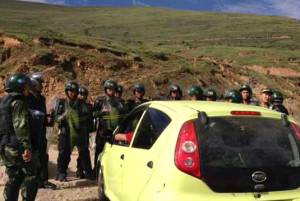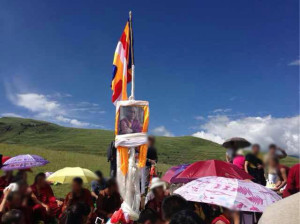- Two Tibetan monks were shot in the head and several others seriously injured after Chinese police opened fire at a crowd gathered to peacefully celebrate the 78th birthday of the Dalai Lama in Nyitso, Tawu, eastern Tibet, on Saturday (July 6).
- Despite the intimidating presence of high numbers of armed troops, many Tibetans still gathered in various areas of Kham and Amdo to light incense, make offerings and pray to mark the Dalai Lama’s birthday on July 6. In some areas the Dalai Lama’s picture was displayed prominently. The news follows reports that there have been discussions in some areas about allowing Tibetans to worship the Dalai Lama as a religious leader.

Troops gather at Tawu to prevent the religious celebrations of the Dalai Lama’s birthday.
The Tibetans, including laypeople, monks from nearby Nyitso monastery and nuns from Gedhen Choeling nunnery, had gathered on the lower slopes of a mountain regarded as sacred near Nyitso village to mark the Dalai Lama’s birthday on July 6. Celebrating the Dalai Lama’s birthday in accordance with Tibetan tradition, they burned incense, cast prayer flags (lungta) into the air and made offerings. Local Tibetans had burned incense at the top of the holy mountain earlier that morning, and later joined the rest of the Tibetans on the hillside to offer khatags (greeting scarves) to a photograph of the Dalai Lama.
Large numbers of armed police and soldiers were deployed, with one source reporting at least seven army trucks and police vehicles at the scene. The security forces attempted to prevent Tibetans from making their offerings and gatherings, but according to two Tibetan sources in exile, some Tibetans present argued that burning incense was not a crime. Without warning, according to several Tibetan sources, police opened fire on the unarmed crowd and used tear-gas.
The monk depicted in images received from Tibet has been named as Tashi Sonam, who is now in hospital in Dartsedo, according to the same sources. Most of the Tibetans who were shot are in the same hospital and have been identified so far as Tsering Dhondup, a ‘disciplinarian’ monk at Nyitso monastery, a layperson, Tashi Gyaltsen, two other laypeople named as Tashi and Nyandak, and two nuns. A monk, Jangchub Dorjee, was also injured in the shooting; a Tibetan former political prisoner in exile from Tawu said that he is the younger brother of Palden Choetso, a nun from the Ganden Jangchup Choeling Nunnery in Tawu who set fire to herself and died on November 3, 2011. (ICT report, Tibetan nun self-immolates in Kardze: continued resistance despite Chinese crackdown)[1].
According to the same Tibetan sources, a number of Tibetans were detained after the incident and at least 20 remain in custody in Tawu.
The shooting on July 6 in Tawu follows the self-immolation of a Tibetan nun, Wangchen Dolma, near Nyitso monastery last month, during a gathering of several thousand monks for an inter-monastic debate and teaching. The nun, in her early thirties, died on June 14. After the self-immolation, communications were restricted in the area and surveillance of monks at Nyitso monastery, a historical center of Tibetan culture, was intensified. (ICT report, Tibetan nun dies after self-immolation near monastery hosting major religious teaching).
Tibetans in the area are known for their strong sense of Tibetan identity and since 2008, security forces in Tawu have responded harshly to peaceful expressions of dissent and gatherings of Tibetans for cultural and religious purposes.
In 2011, security personnel were deployed at the same location as the shooting in Tawu to prevent peaceful celebrations of the Dalai Lama’s birthday, and thousands of Tibetans were stopped from making offerings at a holy mountain during the early hours of the Dalai Lama’s birthday. Even so, images emerged depicting plumes of incense smoke, burnt as an offering for the well being of the Dalai Lama, arising from houses on a hillside in the area on the birthday of the exiled religious leader that year (ICT report, Powerful images of Dalai Lama’s birthday celebrations in Tibet).
This year, Tibetans gathered elsewhere in Kardze to mark the Dalai Lama’s birthday on Saturday, with a traditional celebration involving dance and performance in Lithang (Chinese: Litang), including a display of his photograph.
Dalai Lama birthday celebrations in Kham and Amdo

Tibetans gather to celebrate the Dalai Lama’s birthday.
In the Labrang area of Amdo (Kanlho Tibetan Autonomous Prefecture, Gansu), a large number of Tibetans gathered to mark the birthday, in an area away from the monastery, while in Chabcha (Chinese: Gonghe) in Tsolho (Chinese: Hainan) Tibetan Autonomous Prefecture in Qinghai, an image of the Dalai Lama was displayed in one monastery. Tibetans marked the birthday in Draggo (Chinese: Luhuo) in Kardze,[2] Sichuan, and Darlag (Chinese: Dari) in Golog (Chinese: Guoluo), Kumbum and Rebkong (Chinese: Tongren) in Qinghai.
The gatherings this year at the time of the birthday are evidence of Tibetan resilience and determination to practice their religion and demonstrate the importance of the Dalai Lama in their lives despite an intimidating security crackdown and increasingly repressive policies across Tibet.
A Tibetan researcher in exile said: “Before the protests and crackdown in 2008, Tibetans in Kham and Amdo would not usually hold large gatherings to mark the Dalai Lama’s birthday. But this year it seems that the imperative was there to do so. It indicates a continued determination not only to express their loyalty to their religious leader, but also it is a statement about the importance of His Holiness as a symbol of the Tibetan cause. In many of these places there have been self-immolations, and these have left a deep emotional impression.”
In some Tibetan areas, Tibetans have specifically held religious ceremonies close to or on the date of the Dalai Lama’s birthday, partly in order to avoid restrictions due to anti-Dalai Lama policies. In Tawu, Tibetans previously invited monks to a traditional religious festival at the holy mountain in January each year. In 2004, the date of the festival was changed to July 6, the Dalai Lama’s birthday, and it was on this occasion that troops opened fire this year.
The two monks who were shot in the head at Tawu are both from Nyitso monastery, which is located within Tawu county town and is populated by more than 200 monks (prior to the Cultural Revolution nearly 2,000 monks are believed to have been based there). Nyitso has more than 400 years of history and is recognized as a protected heritage site in Sichuan. Monks from other areas of Kham and Amdo frequently come to Nyitso to study, while monks from Nyitso also travel elsewhere for study. There is a school within the monastery for young monks to learn grammar, philosophical debate, Buddhism, history, poetry and literature, taught in the Tibetan language.
Proposals to display portraits of the Dalai Lama, end denunciation of the Tibetan leader, and lessen police presence in monasteries were discussed at a series of meetings in Qinghai in recent weeks, including a discussion at Chabcha, although it is not known whether they will be implemented on an experimental basis or not. (ICT report, New challenges to Tibet policy from inside China). In the Tibet Autonomous Region there is no sign of any images of the Dalai Lama or celebrations of the birthday being allowed, as the anti-Dalai Lama campaign has been stringently enforced as a core policy in the area since the mid-1990s.
In the eastern Tibetan areas outside the Tibet Autonomous Region, images of the Dalai Lama have been on display for some years, although the authorities have taken a more aggressive approach against their display since the protests and crackdown in 2008 – particularly in monasteries connected to self-immolations.
[1] Tsewang Norbu, a Nyitso monk, was the third Tibetan monk to self-immolate in Tibet. He set himself on fire and died on August 15, 2011 (ICT report, Troops surround monastery as Tibetan monk dies after setting himself on fire and calling for the return of the Dalai Lama to Tibet).
[2] In an incident in January, 2012, armed police opened fire on unarmed Tibetans in Draggo (ICT report, Three Tibetans shot dead on first day of Chinese New Year)

